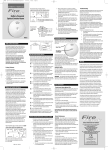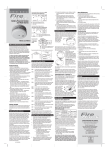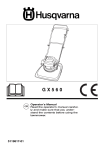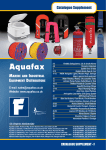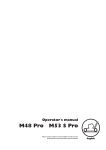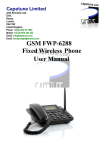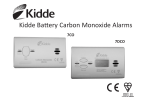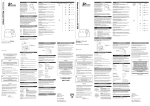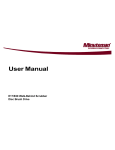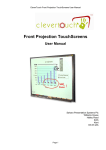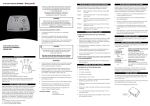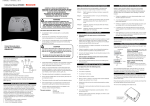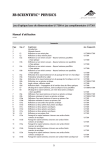Transcript
BACK HOW TO MAINTAIN YOUR ALARM Testing the alarm Test the alarm once a week using the test button. It should flash all three LEDs once, one after another, followed by 4 beeps from the sounder. Cleaning the alarm Regular cleaning of the alarm is essential if it is to work properly. Keep free of dust and vacuum it every month and ensure the vents are clear. Every six months wipe the outside with a damp cloth to remove staining and grease from cooking etc. Battery Information The battery is sealed in and is not replaceable. It should last 7 years; the life of the alarm. After approx. 7 years the alarm will beep three times every minute to indicate end of life. At this point the alarm should be replaced. Extended periods in alarm mode can significantly reduce the life of the battery. AUTOMATIC FAULT DETECTION In the unlikely event of a fault developing in your alarm, it will emit two beeps every minute (see Table 1). If this happens DO NOT OPEN THE ALARM, there are no user serviceable parts inside. Remove it from the baseplate to turn it off and return it to the manufacturer at the address at the end of this handbook. WHAT IS CARBON MONOXIDE? Carbon Monoxide (CO) is an extremely poisonous gas. It is a colourless, odourless and tasteless gas released by the incomplete combustion of fossil fuels such as natural gas, bottled gas, petrol, diesel, oil, paraffin, wood, coal coke and bio-fuels. When inhaled, it causes chemical asphyxiation, when CO mixes with the blood and reduces the oxygen carried around the body, in particular to the brain. The following symptoms are typical of CO poisoning and should be discussed with all members of your household. Mild Exposure: Slight headache, nausea, fatigue, often thought to be flue symptoms. Think CO. Medium Exposure: Severe throbbing headache, drowsiness, confusion, vomiting and fast heart rate. Extreme Exposure: Unconsciousness, Convulsions, Cardio-respiratory failure, death. Although feeling unwell, victims of CO poisoning become so disoriented that they can no longer decide what to do next, including being unable to exit the building or call for assistance. Very young children often show symptoms earlier than adults. Being affected while asleep is the most dangerous situation as the victim will not wake as a result. Holiday Accommodation. Take particular care when using holiday accommodation at home or abroad. Make sure you understand the type of appliances you are using and take note of the fuel being used. The CO7B range of Carbon Monoxide alarms are particularly suitable for this. Always take the handbook with you and read these instructions. HAVING A WORKING CARBON MONOXIDE ALARM IN YOUR PROPERTY SHOULD NOT BE SEEN AS A REASON TO AVOID THE REGULAR SERVICING OF FUEL BURNING APPLIANCES. PRODUCT WARRANTY Firebiltz Ltd guarantees to you, as a purchaser, that the enclosed Carbon Monoxide alarm will be free from defects in material, workmanship or design under normal use and service for a period of 7 years. This Guarantee is not assignable. Our liability to you, under this guarantee is limited to repairing or replacing any part which we find to be defective in material, workmanship or design, free of charge to the customer, upon sending the alarm with proof of date of purchase, postage paid to Fireblitz Ltd, Units 15-17 Manford Industrial Estate, Manor Road, Erith, Kent DA8 2AJ. The terms of this guarantee will not apply in the following circumstances: If the alarm has been modified, dismantled, contaminated, damaged, neglected or otherwise abused or altered following the date of purchase, or if it fails to operate due to incorrect siting, installation, or damage caused by failure to abide by the instructions supplied. It is specifically drawn to the users attention that substantial periods in alarm will shorten alarm life, during which time it will have provided valuable protection and no claim under the guarantee will be entertained. The liability of Fireblitz Ltd, arising from the sale of this alarm or under the terms of this guarantee shall not in any case exceed the cost of replacement of the alarm. In no case, shall Fireblitz Ltd be liable for consequential loss or damage resulting from the failure of the alarm or the breach of this or any other guarantee, express or implied or for damage caused by failure to abide by the instructions supplied. This guarantee does not affect your statutory rights. IMPORTANT: This device is not suitable as a smoke, fire or combustible gas detector. It should not be regarded as a substitute for the proper servicing of fossil fuel burning appliances such as gas, oil, paraffin, bio-fuel, wood, coke, charcoal or coal fired boilers, room heaters and cookers etc, or their flues. Fireblitz Extinguisher Ltd. Units 15-17 Manford Industrial Estate, Manor Road. Erith, Kent DA8 2AJ Telephone: 01322 342238 Email: [email protected] TYPICAL CAUSES OF CARBON MONOXIDE IN THE HOME ARE Incorrect Installation of Equipment Always use a registered Gas Safe Installation Engineer. Faulty Equipment; Cracked /blocked flues or cracked heat exchangers Insufficient Ventilation for Complete Combustion. Where appliances take air for combustion from the room such as open wood and coal fires, portable gas or paraffin heaters or space-heating boilers, the room MUST have adequate ventilation to allow sufficient air for complete combustion. DO NOT block up room vents specifically provided for this purpose. Appliances Competing for Air Supply Where there is more than one appliance taking air from a room ensure that there is an adequate supply. Consult your Gas Safe Engineer Air tightness of the Property. This can happen if there is a lack of unobstructed ventilation in the presence of double glazing. ALARM DESCRIPTION The CO7B range of alarms will go into the alarm condition under the following circumstances: Carbon Monoxide Level No Alarm Alarm (Parts per million) BeforeBefore 30 ppm 50 ppm 100ppm 300ppm 120 mins 60 mins 10 mins - 90 mins 40 mins 3 mins PRODUCT DESCRIPTION The FireHawk CO7 range battery operated Carbon Monoxide alarm is ideal for the home and travelling on holiday. It’s compact size takes up little room in the baggage but gives you invaluable protection from faulty heating and cooking appliances wherever you are. If fitted, the LCD display on the CO7BD allows you to read harmful levels of Carbon Monoxide (CO) in ppm (parts per million) at the click of the display button. Further clicks show the peak CO levels in the previous 12 hours and % COHb (carboxy-haemoglobin or CO in the blood). Three LED’s on the front of the alarm indicate Alarm (red) when the alarm has detected harmful levels of CO; Power, (green) flashes one every minute when the alarm is operating and Fault (yellow) indicates a fault in the alarm. All three LEDs operate with different sound patterns as shown in the Table 1. WHAT TO DO IF THE ALARM SOUNDS If the alarm sounds a repeating series of 4 beeps, (see Table 1) evacuate the property immediately. If it is not possible for all occupants to exit the property for any reason, call for help, open all doors and windows to ventilate it and move to fresh air. IN THE CASE OF SUSPECTED CARBON MONOXIDE (CO) POISONING, SEEK MEDICAL ASSISTANCE IMMEDIATELY. If it is safe to do so, turn off all appliances, shut off the gas supply tap and: WHAT ARE THE POTENTIAL SOURCES OF CARBON MONOXIDE? A correctly operating and serviced fossil fuel burning appliance should allow complete burning of the fuel and therefore is not a hazard. You should have all such appliances serviced at least once a year by a fully qualified Gas Safe registered engineer. TYPICAL SOURCES OF CARBON MONOXIDE AROUND THE AVERAGE HOUSEHOLD ARE: Room heaters; such as real flame fires, wood-burners, ranges; open coal, coke and wood fires, portable gas and paraffin heaters. Central heating boilers. Oil fired and gas central heating boilers, wood-burners and automated feeders for coke and coal. Cookers and solid fuel ranges. NOTE: Cooker hoods without flues will not remove CO. Barbecues and chimneas used outside but close to the property Petrol and diesel driven engines such as cars, motorbikes, lawn movers, strimmers, rotovators, chain saws etc, especially when run up inside the garage or garden shed. Cigarette, cigar and pipe smoke. Carbon monoxide from burning tobacco can build up over even a short time, particularly in a poorly ventilated property. Blocked flues from fires, ranges and boilers. A partially blocked flue will cause a build up of unburned gasses in the system and, if damaged by building movement or poor condition, could either severely affect complete burning or leak combustion gases into the property, particularly when they take air from the room to improve efficiency of exhaust. WARNING: This apparatus is designed to protect individuals from the acute effects of carbon monoxide exposure. It will not fully safeguard individuals from specific medical conditions. If in doubt consult a medical practitioner. 7 CALL TRANSCO ON 0800 111 999 YEAR SENSOR WARRANTY BATTERY OPERATED Carbon Monoxide Alarm MANUAL Do not silence the alarm or re-enter the property until the source of Carbon Monoxide (CO) has been found and dealt with by a competent and registered Gas Safe engineer. Table 1 Carbon Monoxide Present Alarm Test Low Battery Fault End of alarm life Repeating Series of 4 beeps with Red LED One series of 4 beep with green, yellow and red LEDs One beep every minute Two beeps every minute with red and yellow LEDs Three beeps every minute •••• •••• •••• •••• • • • • •• •• •• •• ••• ••• ••• The alarm will reset itself if the CO dissipates naturally. If it is necessary to manually reset the alarm after the fault has been attended to, press the Test/Reset button. LCD Display (if fitted) LED Indicators Test/Display Buttons Sounder BS EN50291: 2001 License No: KM573122 READ AND RETAIN THIS USER MANUAL WHERE TO INSTALL YOUR ALARM The design and layout of domestic premises and the number, type and position of carbon monoxide sources vary widely. However, general guidance is given below on where and where not to locate the alarm in order to minimise the risk of misleading indications. Which room? Ideally, an alarm should be installed in every room containing a fuel burning appliance. Additional alarms may be installed to ensure that adequate warning is given for occupants in other rooms, by locating alarms: a. in remote rooms in which the occupant(s) spend considerable time whilst awake and from which they may not be able hear an alarm from an alarm in another part of the premises, b. and every sleeping room. However, if there is a fuel burning appliance in more than one room and the number of alarms is limited, the following points should be considered when deciding where best to put an alarm: c. locate an alarm in a room containing a flueless or open-flued appliance, and d. locate an alarm in a room where the occupant(s) spend most time. e. If the appliance is in a room not normally used (for example a boiler room), the alarm should be put just outside the room so that the alarm may be heard more easily. If that room is remote, then the guidance in points a. and b. above should be considered. Where in the room? It should be possible to view all the light indicators on the alarm when in the vicinity of the chosen location for the alarm. It is not possible to give specific guidance on the exact location of a alarm which suits all types of room and their usage. The following points should be taken into consideration when determining an optimum location for any appropriate situation: Where not to install the alarm The alarm SHOULD NOT be installed: • in an enclosed space (for example In a cupboard or behind a curtain); • where it can be obstructed (for example by furniture, books or ornaments); • directly above a sink; • next to a door or window; • next to an extractor fan; • next to an air vent or other similar ventilation openings; • in an area where the temperature may drop below - 10°C or exceed 40°C, • where dirt and dust may block the sensor; • in a damp or humid location; • in the immediate vicinity of a cooking appliance. An alarm located in the same room as a fuel-burning appliance: • If the alarm is located on a wall it should be located close to the ceiling and at a height greater than the height of any door or window. • A ceiling mounted alarm should be at least 300 mm from any wall, and for a wall mounted alarm it should be at least 150 mm from the ceiling. • The alarm should be at a horizontal distance of between 1 m and 3 m from the potential source. If there is a partition in a room, the alarm should be located on the same side of the partition as the potential source. • Carbon Monoxide alarms in rooms with sloped ceilings should be located at the high side of the room. An alarm located in sleeping rooms and in rooms remote from a fuel burning appliance: An alarm that is located in sleeping rooms and in rooms remote from the fuel-burning appliance should be located relatively close to the breathing zone of the occupants. (The breathing zone should be regarded as the horizontal level in the room where a person’s head spends most of the time, ie while sat in a chair or laid on a pillow. Pay particular attention to the normal location of the elderly and disabled when reaching a decision. For further information contact the manufacturers helpline on 01322 342 238 or CoGDEM (The Council for Gas Detection and Environmental Monitoring) on their helpline 0800 1694 457 Particular attention should be given to sleeping accommodation. Carbon Monoxide is particularly hazardous to a person while asleep as it will not wake them. If they wake and have been subjected to carbon monoxide, they may be too disorientated to know what is wrong with them and what to do next. A Carbon Monoxide alarm at the bed head will help to avoid this situation . WARNING: Do not operate this alarm in areas with temperatures less than -10°C or greater than +40°C; or in humidity less than 30% RH or more than 90% RH. HOW TO INSTALL YOUR ALARM As a portable Device: 1. Assemble the device as shown in Figs. 1 & 2. The alarm will automatically switch on and beep 4 times with lights and display if fitted. Test the alarm using the test button and refer to Table 1. To remove the baseplate and turn off the alarm, see the end of this section. 2. Attach the stand as shown in Fig. 3 3. Place the alarm in your chosen position in free air with no local obstructions and close to the front edge of shelves and surfaces. See “Where to install the alarm” above. Fixing the alarm to a wall: 1. Decide on the position for the alarm in open air and unobstructed from the guidance given above in “Where to install the alarm”. 2. Using the screws and fixings supplied fix firmly to the wall as shown in Fig. 4. Assemble the alarm to the baseplate as shown above in Fig 1. The alarm will automatically switch on and beep 3 times with lights and display if fitted. 3. Test the alarm using the test button and refer to Table 1. NOTE: To Remove the alarm from the baseplate, depress the tag fully towards the back of the baseplate and slide the alarm towards the top. See Fig 5. Fig. 1 Fig. 2 SLIDE DOWN FRONT Fig. 3 Fig. 4 Fig. 5
